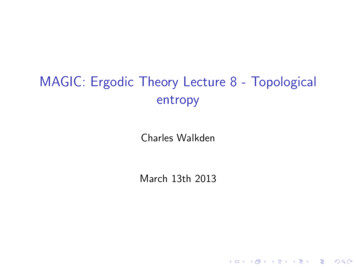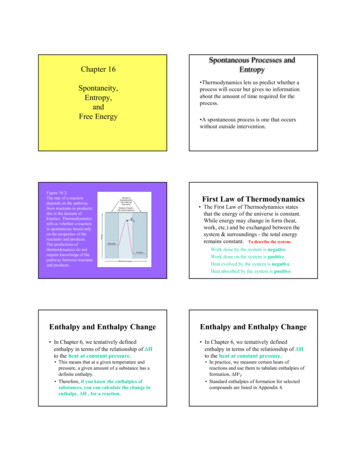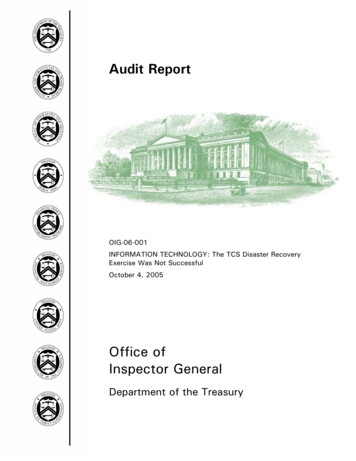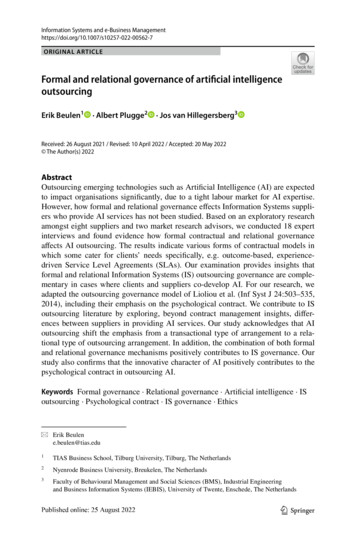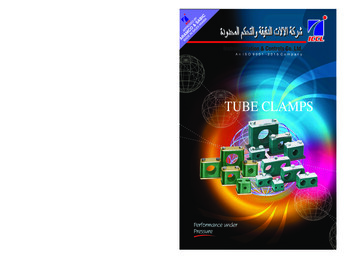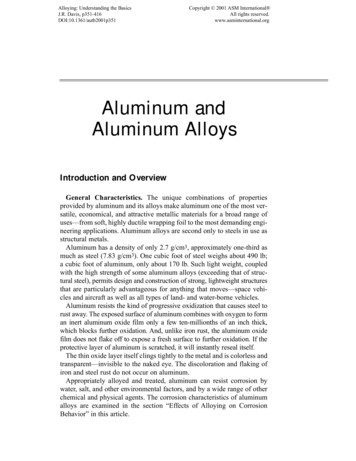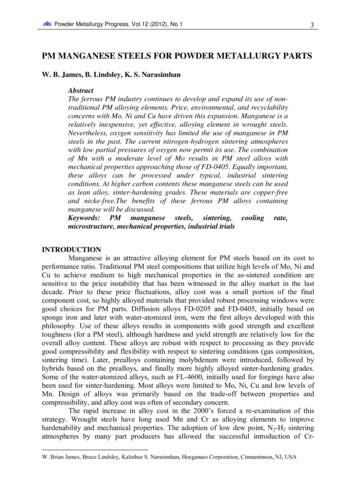
Transcription
TCS High Entropy Alloys Database (TCHEA4)Technical InformationAvailable Starting with Thermo-Calc Version 2020bDocument created 12/4/2020
ǀ 2 of 64ContentsTCS High Entropy Alloys Database (TCHEA4)1About the TCS High Entropy Alloys Database (TCHEA)3TCS High Entropy Alloys Database (TCHEA) Resources5TCHEA4 Elements, Systems, Phases, and Properties Data6TCHEA4 Systems8TCHEA4 Assessed Binary Systems9TCHEA4 Critically Assessed Ternary Systems10TCHEA4 Tentatively Assessed Ternary Systems13TCHEA4 Phases17TCHEA4 Models for the Included Phases18TCHEA4 Properties Data62TCHEA: TCS High Entropy Alloys Database Revision History63www.thermocalc.com
About the TCS High Entropy Alloys Database (TCHEA) ǀ 3 of 64About the TCS High Entropy Alloys Database (TCHEA)TCHEA: TCS High Entropy Alloys Database Revision HistoryTCS High Entropy Alloys Database (TCHEA) is a thermodynamic database for high entropy alloys (HEA)[2004, Yeh; 2006, Yeh]. HEAs are a new class of materials consisting of more than one principal element ina multi-component system. They are also known as multi-principal element alloys (MPEAs) [2013, Wang;2015, Senkov] or complex concentrated alloys (CCAs). The coupling of our CALPHAD based computationaltools and databases allows a high fidelity calculation of thermodynamic properties and phase equilibria inmulti-component HEAs, thus shedding light on the formation mechanism and thermodynamic and kineticstability of HEAs, providing an efficient way to design HEAs for desired materials properties based on theprediction of microstructures through process optimization. In addition to thermodynamic data, it hasproperties data available for viscosity of metallic liquid and molar volume.The current version of the database is TCHEA4.The CALPHAD MethodThe Thermo-Calc databases are developed with the CALPHAD approach based on various types ofexperimental data and theoretical values (e.g. those from first-principles calculations). It is based on thecritical evaluation of all the binary systems and many ternary systems. A hybrid approach of experiments,first-principal calculations and CALPHAD modeling has been used to obtain reliable thermodynamicdescriptions of the BCC, FCC and HCP solutions. That enables predictions to be made for multicomponentalloy systems, especially for HEAs.The extrapolation to higher-order systems helps to understand the phase equilibria in HEAs, so as to predictthe phase formation, phase fractions and phase compositions or to calculate the driving force of forming aphase. All necessary molar volume data and thermal expansion data are assessed or estimated for most ofthe phases.Learn more on our website about the CALPHAD Method and how it is applied to theThermo-Calc databases.Use Case ExamplesThere are examples available to both demonstrate the validation of the database and to showcase the typesof calculations that can be used for different materials or application area.Some case examples of how the TCHEA4 database can be used include:www.thermocalc.com
About the TCS High Entropy Alloys Database (TCHEA) ǀ 4 of 64lllllCalculate various phase diagrams and property diagrams in the assessed systems and higher-ordersystems.Predict solidification behavior of HEAs with a Scheil-Gulliver calculation.Predict a wide variety of equilibrium properties such as phase amount and constitution as a functionof composition or temperature, homogeneity range, or thermo-stability of HEAs.Use the Add-on Diffusion Module (DICTRA) and combine it with TCHEA and compatible kineticdatabases to simulate typical diffusion-controlled phase transformations in HEAs under arbitraryheat treatment conditions.Use the Precipitation Module (TC-PRISMA) and combine it with TCHEA and compatible kineticdatabases, to simulate the concurrent nucleation, growth and coarsening of precipitates.Combining DatabasesIt is possible to combine several databases to make calculations using Thermo-Calc. For more informationrelated to a specific type of problem, contact one of our support specialists at info@thermocalc.com. Theexperts are available to make recommendations on the most suitable database to use for your needs.www.thermocalc.com
TCS High Entropy Alloys Database (TCHEA) Resources ǀ 5 of 64TCS High Entropy Alloys Database (TCHEA) ResourcesInformation about the database is available on our website and in the Thermo-Calc software online Help.llWebsite: On our website the information is both searchable and the database specific PDFs areavailable to download.Online Help: Technical database information is included with the Thermo-Calc software online Help.When in Thermo-Calc, press F1 to search for the same information as is contained in the PDFdocuments described. Depending on the database, there are additional examples available on thewebsite.Database Specific DocumentationllThe TCHEA: TCS High Entropy Alloys Database Technical Information PDF document contains versionspecific information such as the binary and ternary assessed systems, phases and models. It alsoincludes a list of the included elements and summaries of the database revision history by version.The TCHEA: TCS High Entropy Alloys Database Examples Collection PDF document contains a seriesof validation examples using experimental data, and a set of calculation examples showing some ofthe ways the database can be used.Go to the High Entropy Alloys Databases page on our website where you can access thetechnical information and learn more about the compatible kinetic database. Also explorefurther applications of Thermo-Calc to high entropy alloys including links to resources such asexamples, publications, and more.Learn more on our website about the CALPHAD Method and how it is applied to theThermo-Calc databases.www.thermocalc.com
TCHEA4 Elements, Systems, Phases, and Properties Data ǀ 6 of 64TCHEA4 Elements, Systems, Phases, and Properties DataIncluded ElementsThe database has been developed in a 26-element WYZnZrAssessed Systems and PhasesThe most recent version of the database contains:lll310 binary systems, with almost all of these assessed to the full range of composition andtemperature. These can be calculated with the BINARY module in Thermo-Calc Console Mode.493 ternaries are assessed, and 192 of them to the full range of composition and temperature.These can be calculated with the TERNARY module in Thermo-Calc Console Mode.500 solution and intermetallic phases, where nearly all stable phases in all assessed binary systemsand most ternary systems are modeled.About the Included PhasesThe ordered B2 and L12 phases, together with bcc A2 and fcc A1, respectively, are modeled with the socalled partitioning model, which describes an ordered phase and its disordered counterpart using a singleGibbs energy curve. This type of description is of particular importance to be able to predict second ordertransformations between a disordered phase and its ordered structures.Also note that there may be several possible composition sets for the phases named FCC L12 and BCC B2designated by #1, #2, and so on (e.g. FCC L12#1 and FCC L12#2), due to the co-existence of disordered andordered structures or the presence of miscibility gap. The #n suffix (where n is an integer) is generateddynamically by Thermo-Calc when using global minimization and therefore the identification of the phasesshould be determined from their site occupations. It can be found by LIST EQUILIBRIUM with the VXNSoption in the Console Mode or showing the site fraction in moles of the constituent elements in theGraphical Mode. When the site occupancies of the first and second sublattices are equal the phase isdisordered.www.thermocalc.com
TCHEA4 Elements, Systems, Phases, and Properties Data ǀ 7 of 64In Console Mode, you can list phases and constituents in the Database (TDB) module and theGibbs (GES) module. For some phases, supplementary information is included in the definitions.To show the information, it is recommended in the Database (TDB) module to use thecommand LIST SYSTEM with the option Constituents.Properties DataThe properties data for molar volume and viscosity of the metallic liquids is included with the database.You can find information on our website about the thermophysical properties that can becalculated with Thermo-Calc and the Add-on Modules. Additional resources will also be madeavailable on our website in the near future so keep checking back or subscribe to ournewsletter.Below is a summary of the available parameters and variables for this database when working inThermo-Calc. There are differences when you are working in Console Mode versus Graphical Mode as wellas if you use the TC-Python SDK. More details are described in the online help.PropertyModel Parameters in TDB FileVariables to Show or Plot in Console Mode and TC-PythonDynamic viscosityVISC RTLN(DVIS)DVIS for a system DVIS(PHI) for phase PHIKinematic viscosityVISC RTLN(DVIS)KVIS for a system KVIS(PHI) for phase PHIMolar volumeV0, VAVM for a system VM(PHI) for phase PHIwww.thermocalc.com
TCHEA4 Systems ǀ 8 of 64TCHEA4 SystemsIn this section:TCHEA4 Assessed Binary Systems9TCHEA4 Critically Assessed Ternary Systems10TCHEA4 Tentatively Assessed Ternary Systems13www.thermocalc.com
TCHEA4 Systems ǀ 9 of 64TCHEA4 Assessed Binary SystemsThese are the assessed binary systems (310 in total) in the full range of composition and temperature.www.thermocalc.com
TCHEA4 Systems ǀ 10 of 64TCHEA4 Critically Assessed Ternary SystemsThese are the assessed ternary systems in the full range of composition and temperature.Assessed Ternary -ReC-Nb-TiC-Nb-WC-Ni-Tawww.thermocalc.com
TCHEA4 Systems ǀ 11 of 64Assessed Ternary -TiNb-Ti-Vwww.thermocalc.com
TCHEA4 Systems ǀ 12 of 64Assessed Ternary -ZrTi-V-WTi-V-ZrTi-W-Zrwww.thermocalc.com
TCHEA4 Systems ǀ 13 of 64TCHEA4 Tentatively Assessed Ternary SystemsTernary Systems Tentatively m
TCHEA4 Systems ǀ 14 of 64Ternary Systems Tentatively VCr-Ti-WCr-W-Zrwww.thermocalc.com
TCHEA4 Systems ǀ 15 of 64Ternary Systems Tentatively -Re-TaNb-Re-Tiwww.thermocalc.com
TCHEA4 Systems ǀ 16 of 64Ternary Systems Tentatively rSi-W-ZrTa-W-Zrwww.thermocalc.com
TCHEA4 Phases ǀ 17 of 64TCHEA4 PhasesIn this section:TCHEA4 Models for the Included Phases18www.thermocalc.com
TCHEA4 Phases ǀ 18 of 64TCHEA4 Models for the Included PhasesName )2(Al)11the Al-Mn-Znternary Thermodynamic Model and Phase w.thermocalc.comNotesTau3also Al12Mo,
TCHEA4 Phases ǀ 19 of 64Name tSG#Thermodynamic Model and Phase e4 (HT)oB ns ofAl13Fe4 (akaAl3Fe) & 13(Ni)0.38(Zn)0.49AL15SI2M4 Fex Al4structureunknownAL1MN1SI1TiSi2oF24FdddAL23CUFE4 D2HAl6MnoS28CmcmIm-3204D2 )1(Si)1the Al-Mn-Siternary phase,Tau363(Al)23(Cu)1(Fe)4www.thermocalc.com
TCHEA4 Phases ǀ 20 of 64Name 54P63/mmcAL24MN5ZNStrukturberichtSG#Thermodynamic Model and Phase 24the Al-Mn-Znternary phase,Tau1Tau1,Mn6 xCu4 )2(Mn)2(Si)3the Al-Mn-Siternary 3the Al-Mn-Siternary phase,Tau10AL2TI Co)1AL2TI3N2Ti3Al2N2hP22P6 3mc186(Al)2(Ti)3(N)2AL2W C40CrSi2hP9P6 Zr,Hf,Y)3C40www.thermocalc.comalso Al2Hf3, Al2Y3
TCHEA4 Phases ǀ 21 of 64Name hermodynamic Model and Phase Ni2hP5P-3m1AL3NI5Ga3Pt5oS16CmmmoP*PnmaAL3RH LTAL3TID022Al3TitI8I4/mmmAL3TI LTAl3TitI32I4/mmmD018Notesaka CoAl3 cub(Al)0.75(Ir)0.25(Al)3(Mn)4(Si)2the Al-Mn-Siternary phase, Dor Tau585(Al)3(Mn)1(Si)2the Al-Mn-Siternary phase,Tau4D0 1162(Al)0.75(Ni)0.25D5 0.375(Ni)0.625also Ti,Zr,Al)1www.thermocalc.comgamma doubleprime, Al3M/Ni3V,BCT D022
TCHEA4 Phases ǀ 22 of 64Name indatabasePrototypePearsonSpacegroupAL3Y HTBaY3hR36AL3Y LTMg3CdAL3ZRD023StrukturberichtSG#Thermodynamic Model and Phase lso Al3Hf, Zn3ZrAL3ZR2Al3Zr2oF40Fdd243(Al)3(Zr,Hf)2also Al3Hf2AL3ZR4Al3Zr4hP7P6/mmm191(Al)3(Zr,Hf,Ti)4also (Al)4(Mn)1AL4REAl4ReaP71P-12(Al)4(Re)1D 023D8 mD7 1www.thermocalc.comNotesalso AL461MN107
TCHEA4 Phases ǀ 23 of 64Name tSG#Thermodynamic Model and Phase constitutionAL4SIC4E94Al5C3NhP18P6 3mcE9 8P63/mmc194(Al)5(Rh,Co)2D8 11AL5CU4ZNNotesalso Al4Moalso 6SI7CrSi2hP9P6 222AL5RH2HTRhAl2.63cP54P23(Al)2(Va,Rh)1AL5TI2 2P6 l)1also AL8FE5 calc.comthe Al-Mn-Siternary phase,Tau2aka AL11TI5also AL5MO
TCHEA4 Phases ǀ 24 of 64Name known(Al)63(Mo)37Mo3Al5 HTAL6MND2HMnAl6oS28(Al)6(Ru,Re,Fe,Mn)1also Al6Re, oupCmcmStrukturberichtD2 hSG#63Thermodynamic Model and Phase 4C2/m12(Al)7(V)1AL7W3*structureunknownAL8CR5HT D82Cu5Zn8cI52I-43mD82217(Al)8(Cr)5AL8CR5LT l)7(W)3www.thermocalc.comNotes
TCHEA4 Phases ǀ 25 of 64Name 52I-43mAL9CO2Al9Co2mP22P2 1/cAL9CR4HT*structureunknownAL9CR4 LTAl9Cr4cI52I-43m?(Al)9(Cr)4AL9IR2Al9Co2mP22P2 ALPHAAlB12-atP213P4 156R3m160(Al)2(Cu,Fe)3SG#Thermodynamic Model and Phase constitution12(Al)8(Mo)3Notes(Al)8(Si)1(C)7D8 2217(Al)8(V)514(Al)9(Co,Rh)2also he Al-Mn-Znternary phase,Tau2MAX PHASE
TCHEA4 Phases ǀ 26 of 64Name tSG#Thermodynamic Model and Phase constitutionNotesALCUEPS on2 HTALCU ETAAlCumS20C12/m112(Cu,Al)1(Zn,Fe,Cu,Ni)1united HT-eta1 ka THETA PRIMEALCUZETAAl9Cu11oI24/oF88Imm2 /Fmm244/42(Al)9(Fe,Cu)11united HT-zeta1and LT-zeta2ALCU3MN2 P24I4/mcm/ (Si)12(Al)2(Fe)2(Si)1www.thermocalc.com
TCHEA4 Phases ǀ 27 of 64Name tureunknownALMNSITAU8Mn3Al10hP26P63/mmcALMO A2WcI2Im-3mALN B4ZnOhP4P6 3mcStrukturberichtSG#Thermodynamic Model and Phase lso AlCo3C,AlFe3C(Al,Mn)4(Si)1the Al-Mn-Siternary 2the Al-Mn-Siternary 1ALRE r2tI6I4/mmmC11 b139(Al)1(Re)2ALRH2ALSI3TI2Notesan ordered .5(Ti)0.333333www.thermocalc.comaka Ti7Al5Si12,Tau1
TCHEA4 Phases ǀ 28 of 64Name tALTI CdMg3hP8P63/mmcALTI3NE21CaTiO3cP5ALY2 C37Co2SiALZR B33SG#Thermodynamic Model and Phase n)1(V,Mn,Cr,Ti,Sn,Ta,Mo,Co,Al,Nb,Zr,W)1Solution ofordered L10194(Al)1(Ti)2(N)1D0 2B4C MEGAInNi2hP6P63/mmcB82BCC A2WcI2Im-3mA2BCC B2CsClcP2Pm-3mB2also Ni3Sn LT,Mn3Sn, Ti3Snalso AlHf, ALY Cu,Nb)1(C,B,Va,N)3BCC A2 will becombined to BCCB2 if Ni)0.5 (C,B,Va,N)3This phase hassome contributionfrom BCC A2www.thermocalc.com
TCHEA4 Phases ǀ 29 of 64Name indatabasePrototypePearsonSpacegroupBCT A5beta-SntI4I41/amdBETARHOMBOBbeta-BhR105R-3mBN B4ZnShP4P6 G#Thermodynamic Model and Phase constitutionNotes(Sn,Al,Ni,Zn,Cu)1Disordered BCTsolution ,W,Hf,Ni,Cr,Ti,Nb,Ta)1CBCC ENTITE )1CHI i,Nb,Cr,Al,Hf)10B4also o,Cu,Si,Ni,Fe,Rh)1www.thermocalc.comalso M5Re24,
TCHEA4 Phases ǀ 30 of 64Name 2CO1SN3StrukturberichtC11BSG#Thermodynamic Model and Phase constitutionNotes(Ni,Ta,W,Mo,Re,Fe,Nb,Cr)24Mo2Re8, hP22P6 3/mCO5Y D2DCaCu5hP6P6/mmmCO5Y8Co5Y8mP52P2 1/cunited comalso Ni2Si (delta)
TCHEA4 Phases ǀ 31 of 64Name wnCOSN B35CoSnhp6p6/mmmCOSNTITAU2MgAgAscF12F43mCOY B33CrBoC8CmcmSG#Thermodynamic Model and Phase DELTA(Ni,Co,Fe)0.5(Sn)0.5also FeSn, akaCOSN HP6(Co,Ni)1(Sn)1(Ti)1aka TiCoSn(Co)1(Y)1aka COY BF(Co)0.117647(Zn)0.882353Zn15Co2 HT phase(Zn,Co)1(Va)1aka Zn11Co2,COZN4 MA1Zn7.8ComS28C12/m1(Co)0.125(Zn)0.875aka 9285714aka CoZn13COZN HTD83217(Zn,Co)1(Va)1www.thermocalc.com
TCHEA4 Phases ǀ 32 of 64Name tSG#Thermodynamic Model and Phase constitutionCOZN LTA13beta-MncP20P4 132A13213(Zn,Co)1(Va)1CR2B CBMg2CuoF48FdddC b70(Cr,Re,Mo,Fe)0.66666667(B)0.33333333aka CR2B ORTHCR2NI2SINiTi2cF96Fd-3m227(Cr)5(Ni)5(Si)3the Tau1 20P2 13G3198(Cr)3(Ni)5(Si)2(Va,C)1CR3SI ,Ti)1(C,Va)3also Cr3X, Nb3X,Ti3X, 75also Mo5B3CRB4CrB4oI10Immm71(Cr)0.2(B)0.8CRMN3HT CRSI2 C40CrSi2hP9P6 )1(Zn)13www.thermocalc.comalso NbSi2, TaSi2,VSi2
TCHEA4 Phases ǀ 33 of 64Name 0HF7Ni10Zr7oS68CmceCU10SN3Cu10Sn3hP26P6 3CU10ZR7Ni10Zr7oS68CmceCU15SI4EPS CU2Y HT*hP*CU2Y I ETACu3SioS*/hR27/hR** / R-3 /R-3mCU3SNHTGAMMABiF3cF16Fm-3mCU3SN LTCu3SnoC80CmcmStrukturberichtSG#Thermodynamic Model and Phase )0.25(Zr)0.25D8 6(Cu)2(Y)174(Cu)2(Y)1(Cu)0.825(Si)0.175*/148 /166D03the HT phase(Ni,Mn,Cu)0.76(Si)0.24(Mn,Ni,Zn,Cu,Sn)1Cu3Sn HT solution(Cu,Sn)3(Cu,Sn)1epsilonwww.thermocalc.com
TCHEA4 Phases ǀ 34 of 64Name )0.25(Si)0.292CU4MNSN 13Mg3Ru2cP20P4 i,Sn,Al,Cu)1(Cu,Ni,Mn,Va,Co)1also Co3Sn2, Mn(2-x)Sn, primeA13SG#Thermodynamic Model and Phase omNotesdelta
TCHEA4 Phases ǀ 35 of 64Name ynamic Model and Phase constitutionNotesP6/mmm191(Cu2,Y)1(Cu)5aka Cu6Y )8(Hf)3CU8ZR3Cu8Hf3oP44Pnma62(Cu)8(Zr)3CUB A13beta-MncP20P4 F24Fd3mCUTI CUTI3 L60CuTi3tP4P4/mmmL6 0123(Cu,Ti)1(Ti)3DIAMOND A4CcF8Fd-3mA4227(B,Sn,C,Si,Al)1Pure C, Si orsolution phasesbased on themDIS l,Ni,Ti,Nb,Sn,Zr,Co,Ta,Cu,Cr,Fe,Si,W)1(B,Va,C,N)1A copy of the FCCA1 phase just forthe use in .com
TCHEA4 Phases ǀ 36 of 64Name tSG#Thermodynamic Model and Phase constitutionNotessimulation.DIS MU(Co,Ti,Mn,Nb,W,Re,Cu,Ta,Ni,Cr,Al,Mo,Fe)1Part of thedescription of theMU PHASEDIS 1Part of thedescription of theSIGMA n,Zr,Co,Ta,Cu,Cr,Fe,Si,W)1(B,Va,C,N)1FCC A1 will becombined to FCCL12 if 25 (B,N,C,Va)1This phase hassome contributionfrom FCC A1164(Fe)0.666667(Si)0.333333FCC A1CucF4Fm-3mA1FCC L12AuCu3cP4Pm-3mL1 e,Zn)0.231(Zn)0.461FE4N rmocalc.comOnly stable in (CoCr-Fe)-N when gassuspended
TCHEA4 Phases ǀ 37 of 64Name 3aP*FECN CHIMn5C2FENBZRCFC2 C15StrukturberichtSG#Thermodynamic Model and Phase 2 HTFeSi2-hoC48Cmca64(Fe)0.3(Si)0.7FESI2 072(Zn)0.856(Zn,Va)0.072FEZN4GAMMA1 .745G e,Ni,Mn,Zn)8GAMMAHT
Available Starting with Thermo-Calc Version 2020b Documentcreated12/4/2020. Contents TCS High Entropy Alloys Database (TCHEA4) 1 . providing an efficient way to design HEAs for desired materials properties based on the prediction of microstructures through process optimization. In addition to thermodynamic data, it has
